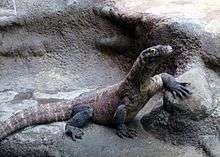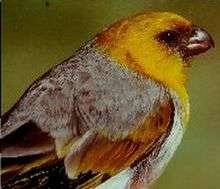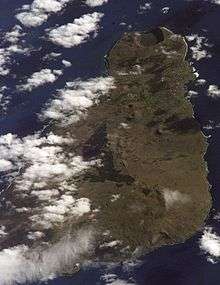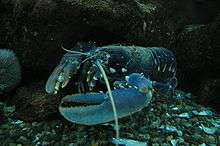Island ecology
Island ecology is the study of island organisms and their interactions with each other and the environment. Islands account for nearly 1/6 of earth’s total land area,[1] yet the ecology of island ecosystems is vastly different from that of mainland communities. Their isolation and high availability of empty niches lead to increased speciation. As a result, island ecosystems comprise 30% of the world’s biodiversity hotspots, 50% of marine tropical diversity, and some of the most unusual and rare species.[2] Many species still remain unknown.
The diversity of species on islands is highly impacted by human activities such as deforestation and introduction of the exotic species. In response, ecologists and managers are directing attention towards conservation and restoration of island species. Because they are simple systems, islands provide an opportunity to study processes of extinction that can be extrapolated to larger ecosystems.
Ecological processes on islands
Islands are attractive sites for ecological research because they provide clear examples of evolution in action. They show interesting patterns of colonization, adaptation, and speciation.
Colonization and establishment
Islands are surrounded by water, and may or may not exist as part of a continental land mass. Oceanic islands arise due to volcanic activity or reef growth, and usually subside over time due to erosion and changing sea levels.[1] When islands emerge, they undergo the process of ecological succession as species colonize the island (see theory of island biogeography). New species cannot immigrate via land, and instead must arrive via air, water, or wind. As a result, organisms with high dispersal capabilities, such as plants and birds, are much more common on islands than are poorly dispersing taxa like mammals.[1] However, some mammals are present on islands, presumably from swimming or riding on natural “rafts” that are washed away from the mainland.
Of the species that arrive, only some will be able to survive and establish populations. As a result, islands have fewer species than mainland habitats. Island populations are small and exhibit low genetic variability (see founder effect), but are isolated from the predators and competitors that they initially evolved with. This can lead to a process called ecological release, where a species is released from its ancestral community interactions and then colonizes new niches.
Adaptation
In response to these changing ecological pressures, island species can become much more docile than their mainland counterparts, and may grow larger (see island gigantism) or smaller (see island dwarfism). Some of these unique adaptations are reflected in charismatic island species such as the giant tortoise, Komodo dragon, or pygmy mammoths.

After immigration, birds, and some reptiles or mammals, tend to become larger and predatory,[3] showing relaxed intraspecific competition.[4] For mammals, small species will increase in size and large species will decrease in size.[5] This is referred to as the “island rule,” and is suggested to minimize energy expenditure.[6]
Other adaptations to life on islands include increased poikilothermy,[6] relaxed anti-predator behavior,[7] and reduced sexual selection[8] in animals, and loss of herbivore defenses[9] and reduced dispersal[10] in plants.
Speciation
The formation of new islands and their isolation from the mainland provides many unoccupied niches for species to adapt to. Since immigration of predators and competitors is limited, many organisms are able to persist in these new niches. This results in a high occurrence of endemism, where species are unique to a localized area. For example, 50% of endemic bird areas are found on islands.[2]
Endemism is often the result of adaptive radiation.[1] Adaptive radiation is when a single specie colonizes an area and rapidly diversifies to fill all of the available niches. A common example is the assemblage of finch species documented by Charles Darwin in the Galapagos Islands. Darwin’s finches exhibited adaptive radiation by evolving different beak sizes to exploit the diversity of seeds present on the different islands.

Because the distributions of these populations are limited by their island habitats, they tend to have fewer individuals than their mainland counterparts and lower genetic variation. This, along with the behavioral and ecological factors mentioned above, makes island species more vulnerable to extinction.[1]
Survival
The continued survival of species on islands depends on factors such as natural selection, genetic variation, natural disturbances (hurricanes, volcanic eruptions) and human-caused disturbances (introduced species, habitat loss). Human-caused disturbances tend to be the greatest cause of mortality, and understanding the causes of extinction facilitates conservation efforts.
Human impacts on island ecosystems
The movement of humans to islands has led to rapid extinction of native island species either from hunting, habitat destruction, or introduced species.
Hunting
Many large animals on islands have been hunted to extinction by humans. A well-known example is the dodo, once found on the island of Mauritius[11]. It evolved to become large, flightless and docile, and was subsequently driven to extinction by humans and introduced predators.
Habitat destruction
The depletion of natural resources can have dramatic effects on island ecology. On Easter Island, the depletion of the forest by humans not only resulted in widespread loss of species, but also the collapse of the island civilization.[12]

Today there are over 500 million people on islands, all dependent on local resources either directly (traditional use) or indirectly (ecotourism revenue). Population growth and development result in heavy deforestation, pollution, and over-exploitation. Overharvesting of ocean fauna is particularly troubling as yields of coral reef fish species are an important food source for island populations.
Introduced species
Humans have contributed to globalization and decreased effective isolation of island communities, allowing for invasion of exotic species. This can have a profound effect on the native species. In Guam, the introduced brown tree snake ate nearly all of the native vertebrate species to extinction. Feral cats and dogs have also greatly diminished native vertebrate populations on islands, through both predation and disease. Introduced ungulates are another major threat, as they graze on native vegetation and can destroy entire forests.[13] Exotic grasses can out-compete native understory species and increase the risk of fire.[14] Lastly, social insects such as ants also cause major problems.[15]
Global warming
Global warming is emerging as a strong cause of species loss on islands. This can be due to sea level rise, the intrusion of salt water into freshwater habitats, or species inability to adapt to increasing temperatures and extreme weather events. Plant species are particularly susceptible.[16] In more isolated areas, such as the Southern Ocean Islands, indirect effects such as invasive species and global warming can play a greater role in influencing populations than overexploitation, pollution and habitat loss.[17]
Trophic cascades
Human activities and the introduction of non-native species often cause trophic cascades, where direct effects on one species result in indirect effects on other species in the food web. An example is on Santa Cruz Island of the California Channel Islands, where DDT poisoning reduced bald eagle populations. This, along with an abundance of introduced feral pigs for prey, allowed golden eagles to colonize the island and replace bald eagles. However, the golden eagles also ate native island foxes. Fox population levels decreased to near extinction, while skunk populations increased due to relaxed competition with foxes.
Island conservation
Conservation on islands
Since island ecosystems are self-contained, it should be possible to mitigate many of the threats to species. Ecologists and managers are working together to prioritize areas for conservation and to quickly design and implement action plans. Not everything can be put into a reserve, so it is important to first compile pertinent information and prioritize areas of concern.[18] Once an area has been chosen, managers must then acquire ownership and gain support. Local experts and indigenous populations should also be involved in this process.[18] Having clearly defined goals will facilitate the many necessary interactions between people and agencies.[18] Once a reserve is in place, managers can then practice adaptive management and do continued community education.
On land, island conservation focuses on the protection of species and their habitat. In some cases, conservation can be integrated with agricultural production. For example, the Acacia koa plantations and wooded pastures in Hawaii are anthropogenically altered ecosystems, yet allow connectivity between forest fragments and thus maintain higher diversity than would open pasture.[19] Other directions include habitat restoration, and eradication of introduced predators, ungulates, and exotic plants (via hunting, removal or biological control).
In marine ecosystems, there has been an increasing establishment of “no-take” reserves. This allows for the reestablishment of native species, and also the augmentation of commercially harvested species.[20] However, in both terrestrial and marine systems, these actions are expensive and do not always result in the desired outcomes. For example, some non-natives become keystone species and their removal can cause more harm than good to the ecosystem. To be more effective, managers of island ecosystems should share information and learn from each other’s mistakes.[21]

Island restoration
Island conservation tends to focus on preservation of individual species and their habitats. However, many ecologists caution that ecological and evolutionary processes should be conserved as well.[21] The conservation of island communities as a whole is closely linked to restoration.
Active restoration on islands can be done for both animal species (translocations, induced breeding) and plant species (reforestation). Creating goals for restoration can be challenging because it is often impossible to restore the ecosystem to its “historic” or “normal” state, if that state can even be clearly defined. Restoration is never complete, as ecological communities are always in a state of change.
Sustainable use
As resource depletion is a major issue on islands, the needs of human populations must also be taken into account. On many islands, scientists and managers are studying traditional practices of indigenous populations as potential conservation solutions. In some cases, limited-take systems that serve the community may provide a better alternative to fully closed protected areas, if there are not enough resources for proper enforcement.[22] Public education plays an important role.
See also
References
- Paulay, G. 1994. Biodiversity on Oceanic Islands: Its Origin and Extinction. American Zoology 34: 134-144.
- Gerlach, Justin. 2008. Island biodiversity - issues and opportunities Archived 2009-03-03 at the Wayback Machine. World Conservation Congress
- Alcover, J. A. and M. McMinn. 1994. Predators of Vertebrates on Islands. BioScience 44(1): 12-18.
- Stamps, J.A. and M. Buechner. 1985. The Territorial Defense Hypothesis and the Ecology of Insular Vertebrates. The Quarterly Review of Biology 60(2): 155-181.
- Van Valen, L.M. 1973. Pattern and the Balance of Nature. Evolutionary Theory 1: 31−49.
- McNab, B.K. 2002. Minimizing energy expenditure facilitates vertebrate persistence on oceanic islands. Ecology Letters 5(5): 693-704.
- Blumstein, D.T. 2002. Moving to suburbia: ontogenetic and evolutionary consequences of life on predator-free islands. Journal of Biogeography 29(5): 685-692.
- Griffith, S.C. 2000. High fidelity on islands: a comparative study of extrapair paternity in passerine birds. Behavioral Ecology 11(3): 265-273.
- Vourc’h, G., J.L. Martin, P. Duncan, J. Escarre, and T.P. Clausen. 2001. Defensive adaptations of Thuja plicata to ungulate browsing: a comparative study between mainland and island populations. Oecologia 126(1): 84-93.
- Cody, M.L. and J.M. Overton. 1996. Short-term evolution of reduced dispersal in island plant populations. Journal of Ecology 84(1): 53-61.
- "Reflections : On Island Ecology and Ecosystem Abuse", Lost Land of the Dodo : An Ecological History of Mauritius, Réunion & Rodrigues, Poyser, 2010, doi:10.5040/9781472597656.ch-011, ISBN 9781472597656
- Bahn, P and J. Flenley. 1992. Easter Island, Earth Island. Thames and Hudson, London.
- Towns, D.R. and W.J. Ballantine. 1993. Conservation and Restoration of New Zealand Island Ecosystems. Trends in Evolution and Ecology 8(12): 452-457.
- D’Antonio, C.M. and P.M. Vitousek. 1992. Biological Invasions by Exotic Grasses, the Grass/Fire Cycle, and Global Change. Annual Review of Ecological Systematics 23: 63-87.
- Cole, F. R., A.C. Medeiros, L.L. Loope, and W.W. Zuehlke. 1992. Effects of the Argentine ant on arthropod fauna of Hawaiian high-elevation shrubland. Ecology 73: 1313-1322.
- Kreft, H., W. Jetz, J. Mutke, G. Kier, and W. Barthlott. 2008. Global diversity of island floras from a macroecological perspective. Ecology Letters 11(2): 116-127.
- Chown, S.L., J.E. Lee, and J.D. Shaw. 2008. Conservation of Southern Ocean Islands: Invertebrates as exemplars. Journal of Insect Conservation 12(4): 277-291.
- Kepler, C.B. and J.M. Scott. 1985. Conservation of Island Ecosystems. ICBP Technical Publication Number 3: 255-271.
- Goldman, R.L., L.P. Goldstein, and G.C. Daily. 2008. Assessing the conservation value of a human-dominated island landscape: Plant diversity in Hawaii. Biodiversity and Conservation 17(7): 1765-1781.
- Towns, D.R. and W.J. Ballantine. 1993. Conservation and Restoration of New Zealand Island Ecosystems. Trends in Evolution and Ecology 8(12): 452-457.
- Cronk, Q.C.B. 1997. Islands: stability, diversity, conservation. Biodiversity and Conservation 6: 477-493.
- Cinner, J.E., M.J. Marnane, and T.R. McClanahan. 2005. Conservation and community benefits from traditional coral reef management at Ahus Island, Papua New Guinea. Conservation Biology 19(6): 1714-1723.